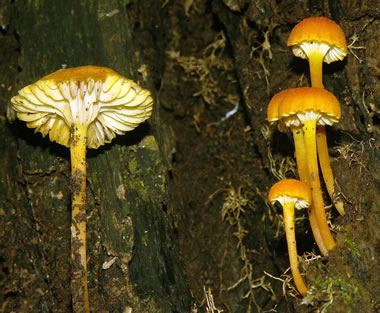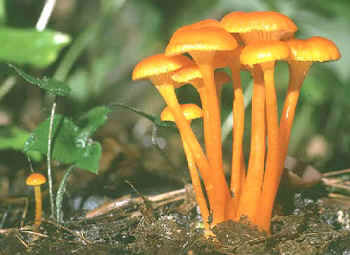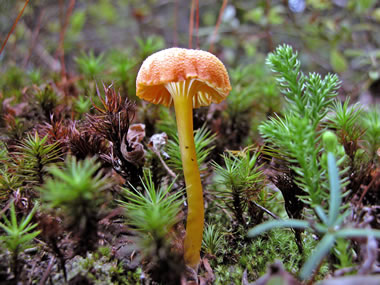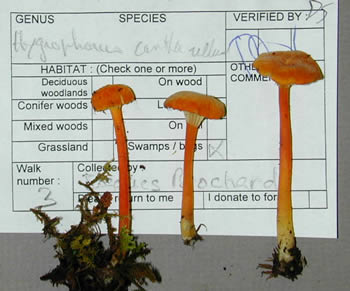Hygrocybe cantharellus
Scientific name: Hygrocybe cantharellus (Schwein.)
Murrill
Derivation of name: Hygr- means "moisture, wetness"
and cybe means "head."
The genus name, then, means
"wet head." Canthar- means "drinking cup" and
ellus
is diminutive. Hence, cantharellus means a "small
drinking cup."
Synonyms: Hygrophorus cantharellus (Schwein.) Fr.
Common name(s): Chanterelle waxy cap.
Phylum: Basidiomycota
Order: Agaricales
Family: Hygrophoraceae
Occurrence on wood substrate: Saprobic; soiltary or in
small
groups on the ground or on well-decayed or moss-
covered logs
and stumps; July through October.
Dimensions: Caps 1-3 cm wide; stipes 2.5-9 cm long, 1.5-5
mm thick.
Cap: Scarlet-red fading to orange-red or paler with age.
Gills: Pale yellow to orangish; decurrent.
Spore print: White.
Stipe: Dry, smooth, color of cap; base yellowish to white.
Veil: Absent.
Edibility: Edible.
Comments: Although its common name suggests an affinity
with the
chanterelles, this mushroom has sharp-edged gills and
not the blunt
ridges characteristic of the chanterelles. Lincoff
notes that this is one of the few hygrophori that
grow on
decaying wood.
More information at MushroomExpert.com:

Figure 1. Several chanterelle waxy caps on rotting wood.
Photo
© Dianna Smith.

Figure 2.
Hygrophorus cantharellus. Photo © George
Barron.

Figure 3. Growing among mosses. Photo
© Dianna Smith.

Figure 4. This is how a specimen of this fungus might
appear
when presented on the tables at a foray. Note
the moss at the base of the stipes.
Photo © Gary Emberger.